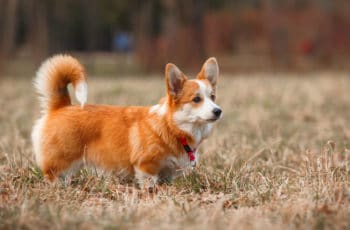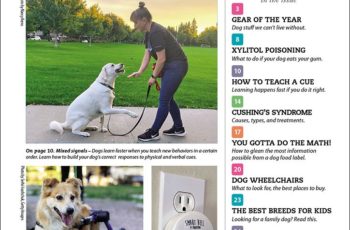-
Home
-
Small Dog Puppies
-
Puppy Development
›
›
By Janice Jones |Last Updated 11-22-2021
Just as in human development, puppy development follows a very predictable sequence of step, although there is no widespread agreement on the exact ages that these milestones occur.
Small dogs grow and develop quickly and often reach maturity
before larger breeds. Puppy development
follows a predicable path yet each puppy is unique and each breed is slightly
different at the various stages of development.
The old rule of each year of a dog’s life is equivalent on seven years
for human is not completely accurate. For most small dogs, the average life
span is approximately 16 years.
Small
dogs mature early and females often have their first heat by the age of 6 or 7
months. By the age of 12 or 13 months,
they are often ready to be bred.
Many changes take place in the first year of life. Puppies go from a relatively helpless neonate
who cannot see or hear or eliminate by himself to a fully grown, agile,
sexually mature adult all in less than 12 months. When do all of these changes take place?
There are seven recognized stages of puppy development:
Stage One: 0-3 Weeks
Stage Two: 3 to 7 Weeks
Stage Three: 7 to 12 Weeks
Stage Four: 12-17 weeks
Stage Five: 17 to 40 Weeks
Stage Six: 40 to 52 Weeks
Stage Seven: 1 year and older
We will first look at puppy development
week by week.
Puppy Development: One to Two Weeks: Neonatal Stage
Milestones:
- Touch, Taste, Smell Working, but hearing and sight is not working,
- Recognizes pain,
- Sleeps and Eats most of the time;
- Cannot regulate their own body temperature.
- Cannot eliminate on own–needs mother to initiate urination and defecation
Needs:
-
Dependent on mother for food and elimination
- If canine mother is not available, human interactions must take over
providing warmth, food and elimination - Dependent on breeder for warm environment
- First worming at the end of this stage
Puppy Development: 2-3 Weeks: Transitional Stage
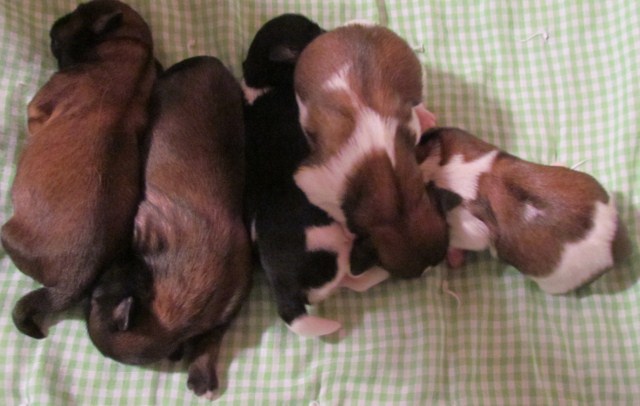
Milestones:
- Eyes and Ears open allowing the puppy to see and hear their environment
- May be able to eat some solid food by end of this period
- First major learning period occurs
- First few steps
Needs:
- Still need for warmth
- Beginning of social interactions with litter mates, mother, and humans
Puppy Development 3-4 Weeks
Milestones
- Puppies begin to understand that humans are different from dogs
- First introduction to canine manners from mother dog
- Some play fighting may occur among litter mates
- Eats solid foods, but continues to nurse
- Begins to eliminate on own
- Becomes more stable on their four paws
Needs
- Introduction to different sounds in the environment, loud noises
- Introduction to different textures, allowed to walk on different flooring
- Second worming at end of this period
Puppy Development: 4-5 Weeks
Milestones
- Teeth may begin to emerge
- Very curious at this stage
- Plays with Litter mates
- Puppies take turns in dominant role
- Weaning continues
Needs
- Needs lots of new experiences
- Puppies need some time away from litter mates and mother to prevent separation anxiety
- Need more human socialization
- Need a good high quality puppy food as puppies nurse less and less
Puppy Development: 5 to 7 Weeks: Curiosity Stage
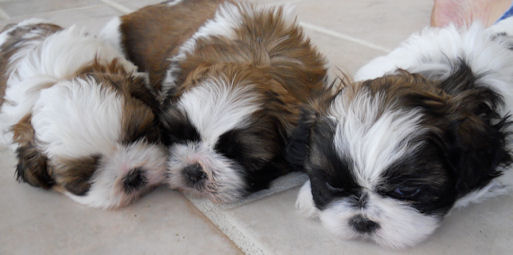
Milestones
- Weaning begins
- May get first set of shots
- Very curious and may venture away from litter mates and mother for short period of time
- Begins to understand boundaries and impulse control
- Mother will spend more time away from puppies
Needs
- Good time for first car ride, first bath
- Not ready to leave litter mates and mother just yet
- Socialization, human interactions, variety of experiences
Puppy Development: 8-11 Weeks
Milestones
- Good coordination, motor skills,
- Most curious phase: Will venture farther and farther away if something catches his interest
- Period of first fear imprinting: Any tramatic event can leave a lifelong impression
Needs:
- Need to safeguard the puppy from any traumatic event
- Need to keep puppy safe from venturing too far.
- Second set of shots usually given during this period
- Still not fully vaccinated, so best to weigh socialization needs with health risks
- If puppy goes to new home at this time, training should begin immediately
- Needs to hear his name often
Puppy Development: 10-16 Weeks
Milestones
- Puppies go to new home
- Past the fear stage
- No longer soiling in his bed,
- Puppy continues to cut teeth: chews on everything
Needs
- Good time for socialization, training to begin: Expose puppy to everything, but be alert to not over do it; stress can be a factor at this age
- Good time for potty training to begin
- Provide lots of chew toys, opportunities to chew on bones
- By end of period, puppy is ready for puppy classes
Puppy Development: 16 Weeks to 6 Months
Milestones
- Becomes more independent
- “Preteen” stage
- First signs of a “big dog attitude” in a small dog
Needs
- More socialization
- More training
- Patience
Puppy Development: 6 Months to One Year
Milestones
- Period begins with beginning of adolescence and ends at sexual maturity
- Very independent : has a mind of his own and likely to show signs of stubbornness
- Second fear stage around 6 months old and may last only a few days or a few weeks
- Girl dogs will go into their first heat period; male dogs get surge of testosterone making them difficult to control–may show up as difficult to manage or disobedient behavior
- Loss of baby teeth and adult teeth come in
Needs
- Continuing training and reinforcement of rules
- Neutering or spaying
- Can move on to adult food at end of this period
Puppy Development: An Overview of Small Dog Development
At birth, your puppy’s eyes and ears are closed. In fact, only 3 senses are working—touch,
taste, and smell and even then they are not fully developed.
They can feel and respond to pain, discomfort
and minor disturbances by whining or crying. Their body temperature is well
below that of a mature dog, and they are unable to tolerate a cool
environment.
For optimal puppy
development, the room temperature must be keep very warm and breeders
accomplish this by maintaining room temperatures around 80 degrees and providing
heating lamps and/or heating pads.
Puppies of this age are also incapable of either urinating or defecating
on their own and depend on their mother to stimulate this process.
Their
first main mission in life is to find warmth and food. They have no teeth, but their nails are fully
developed and some may even need trimming in the first week of life. Their main
activity at this time is to search out nourishment from their mom and sleep.
Newborn puppies sleep most of the time, often
twitching in their sleep and move only to reposition their body. Twitching occurs because at this point in
their young lives, they sleep is the REM stage, a stage characterized by high
brain activity. Beyond that, they have
little interaction with litter mates or the environment other than to huddle
close to litter-mates and mom for warmth.
They depend on their mother to
provide the food they need and to help them potty. Mother also has the assigned task to clean up
after all pottying activity, a job that mother dogs accept happily.
At around two weeks of age, the puppy’s eyes open and then
several days thereafter, their ears open.
At first their vision is blurry but soon vision improves and the puppies
can now see the world at least from their vantage point.
Even into adulthood dogs do not have
particularly sharp vision. Once their
ears open they may begin to startle when they hear sounds. Even from the very beginning, their range of
hearing is nearly twice that of humans and into the ultrasonic range.
At three weeks of age, puppies become somewhat adventuresome
and begin to mover around more, though they are not very sure footed at this
age. This might be equivalent to the
crawling stage in the human infant.
But
progress occurs rapidly and by 3 ½ weeks most puppies are getting around well
on their own four paws. Their eye sight
and hearing are improving daily. This is
also the time that they begin to lap liquids and mouth solid foods if the
consistency is mush-like.
They also begin to have limited interaction with
litter mates, but the majority of this interaction revolves around who is going
to serve as pillow and who is going to serve as blanket as they pile up in one
small corner of the whelping box.
Puppies take turns sleeping on top of the pile and cuddling underneath
and don’t seem to mind either position.
Three weeks is the ideal time for socialization to begin. Puppies have their eyes and ears open and are
beginning to crawl around more and try standing and walking.
By four weeks of age, most puppies have figured out what
“real” food is and continually eat more dog food, nursing less. They are far from being weaned at this
age. They are moving around more and
sleeping less.
This is the time where
socialization to the outside world begins.
Puppies should begin listening to music or TV, hear environmental sounds
such as the dishwasher, hair dryer, can opener, and vacuum cleaner.
It is also a good time to introduce different
textures into their world. They can be
given opportunities to walk on different surfaces such as wood, tile, concrete,
grass, carpet and dirt. Different textures
can be added to their box and puppies can snuggle up against the breeder who is
wearing a variety of different textured clothes.
At four weeks he is also beginning to regulate his own
temperature and feel the urge to pee and poop on his own. He won’t always need Mama to stimulate him to
go potty, yet most good moms continue to clean up after their pups at least for
a while.
By five weeks of age,
he has reached the toddler stage of puppy development and will become very busy interacting with litter
mates and of course humans.
If given
toys at this age, he will explore but rigorous play is still in this young
pup’s future. Mama will try to encourage
her youngsters of this age to wean, making herself less available for free
drinks at any time of the day.
Puppies
show first signs of “play fighting” with litter-mates, but it is too soon to determine
temperaments and canine pecking orders at this time. Some moms actually regurgitate food for their
young, although is not seen very much in domestic dogs.
At six weeks of age, puppies are ready for their first shots
and they should have already had a couple of wormings by now. The tiny breeds may not get their first shots
until around the age of 8 weeks.
Play
takes on new dimensions and toys become fascinating objects. Puppies want to explore and will find ways
explore every inch and cranny of their allotted space. During this period, breeders should continue
to offer stimulation in the form of sounds, smells, and textures and provide
interesting environments for puppies to explore.
Mama continues to teach her puppy manners
especially “bite suppression. Puppies
learn what appropriate canine behavior is and is not through the use of play
and observing other canine body language. These behaviors will be repeated for
two weeks until they become fully weaned and ready to go to their forever
home.
Smaller breeds such as Yorkshire
terriers, teacup toy poodles and Chihuahuas may need more time with mama and
the litter mates. A puppy of 6 weeks is
curious, friendly, outgoing and fully ready to learn.
If socialized correctly he will be completely
ready and eager to please his new human family when that time comes.
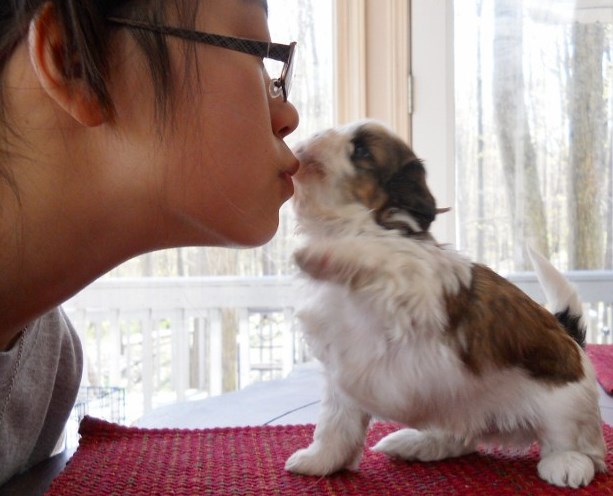
At eight weeks of age, many small breed puppies are ready to
go to their new home. Others will stay
with their canine mother and breeder for another 4 weeks. This is especially true of the smallest of
the toy breeds.
At eight weeks the puppy
begins to experience caution in his action.
At previous stages of puppy development, he was exuberant and reckless, charging forward without any
fear. During the next couple of weeks,
the puppy becomes cautious and checks everything out. IT is important that new owners let nature
take its course as the puppy will get through this stage and move on relatively
quickly.
It is also important that
owners not “cuddle and baby” the puppy during this stage, but rather assure for
the puppy’s safety, but not jump in to rescue them unnecessarily. Some puppies develop fear and anxiety issues
if allowed to be rescued during this time that are hard to correct later on.
If the puppy goes to his new home during this time, the
first few nights will be tough for the little guy as he has not had too much
experience being on his own. Socialization
is very important during this stage of puppy development and will continue to
approximately 12 weeks of age. Before a puppy arrives, your house should be ready including puppy proofed for the puppy’s safety.
The more
new sights, sounds, smell etc. that he can experience the better. Puppies that
have lots of socialization experiences and stimulus during this period will be
much better equipped to handle change as they grow. This is also a great time to begin
training. The first training is potty
training and then simple commands.
Basic
obedience is best started at home and then enrollment in a formal obedience
class once he is fully immunized is always a good idea.
Immunizations are vital to the health of
young puppies and should take priority over any attempts at socialization. For example your young puppy is not ready for
a dog park until all of is immunizations have been given. The best rule of thumb that I have been able
to determine is to treat a pup as if it were a newborn human infant. Anything you wouldn’t do to an infant, you
shouldn’t do to a puppy.
This
is considered to be the puppies “tween” stage because the first signs of
independence is noticeable. We call this
the pre-teen stage in human development.
This is a very demanding stage of puppy development and the well-behaved
little guy who stuck right by your side will suddenly want to ignore you and do
his own thing.
Behavior is a little
erratic during this period and tends to fluctuate from being a sweet cuddly
baby to a stubborn tween. Teething begins
in earnest and the puppy tries to find anything and everything to chew upon,
whether it is a favorite wooden chair or a person’s toes. This is the time when potty training usually
occurs and beginning obedience training such as how to walk on a leash, not
necessarily how to heel.
By the end of
this period, the puppy should have received his third set of puppy shots and a
Rabies vaccination.
It
is during this stage that the growth spurt that your little puppy has
experienced since birth will begin to slow down. You may also notice a decrease in the amount
of food that the small puppy consumes.
One the puppy is fully vaccinated; it is a good time for you and your
puppy to explore the world. He should go
with you on outings whenever possible.
This is also a good time to begin puppy kindergarten and teach your
puppy some basic commands.
Congratulations,
your fur son has reached his teen years.
Attitude is everything during this period. He tries to break all the rules if given the
opportunity and test the limits.
As long
as socialization and training continue, the puppy does not grow into a juvenile
delinquent. He can attend puppy classes and learn basic commands. He will lose his baby teeth and gain a full
set of adult teeth.
Dental care is
important during this time. He or she
will reach sexual maturity some time during this age and it is a good idea to
have him neutered and her spayed. Most
veterinarians recommend sometime by 6 months of age. Your puppy will need discipline, exercise and
lots of chew toys. Your greatest asset
during this stage is Patience!
The
end of this period marks the end of puppy-hood and the beginning of sexual
maturity for small breeds. Small breeds
will reach their full adult size, height and weight.
If your puppy has not been neutered or
spayed, expect to see outward signs of sexual maturity. Females may have gone through their first
heat sometime after 6-7 months of age and by their second heat they are full
ready to take on the role of motherhood.
If males have not been neutered, expect some territory marking. Boys can be fathers as young as 7 months.
At
this point, your puppy is now an adult and can be switched to adult food. There will not be an noticeable changes in
appearance right away and many small breeds tend to keep the playful puppy
personality long into their senior years.
Gradually, the exuberance of youth will begin to fade and if you have
done your job of training and socializing your puppy, your adult dog should
begin to calm down and become more predicable in habits and behavior.
Does This Article Deserve Your Thumbs Up?
We always appreciate your support and encouragement. Your thumbs up means so much to us. Please like this article.
If you find this page or any page on Small Dog Place Helpful, or Useful in anyway, I’d love it if you would click the small heart found on the bottom right of each page.
You can also share or bookmark this page — just click on the:

Free Monthly Newsletter
Sign Up for Our Free Newsletter and get our Free Gift to You.
my E-book, The Top 10 Mistakes People Make When Choosing a Dog (and how to avoid them)

